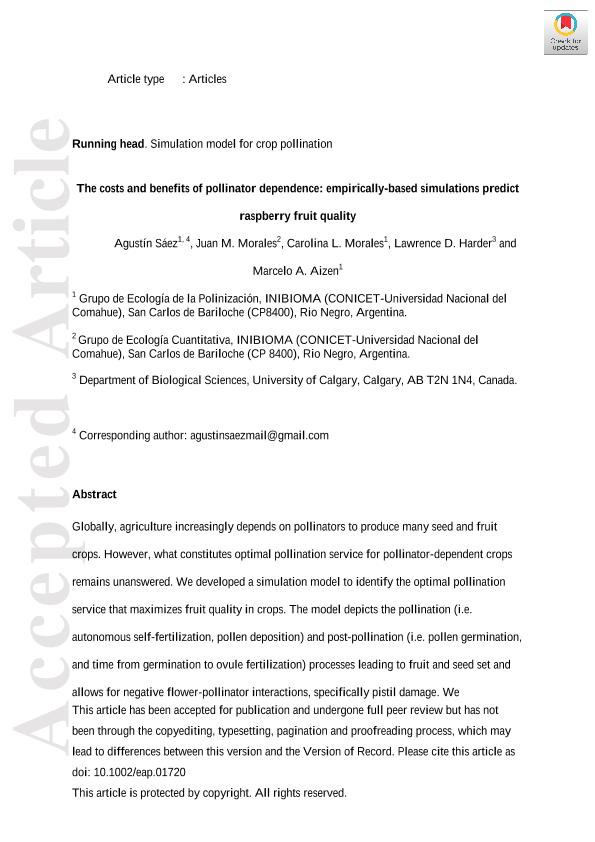Mostrar el registro sencillo del ítem
dc.contributor.author
Sáez, Agustín

dc.contributor.author
Morales, Juan Manuel

dc.contributor.author
Morales, Carolina Laura

dc.contributor.author
Harder, Lawrence D.
dc.contributor.author
Aizen, Marcelo Adrian

dc.date.available
2019-10-22T20:26:41Z
dc.date.issued
2018-07-24
dc.identifier.citation
Sáez, Agustín; Morales, Juan Manuel; Morales, Carolina Laura; Harder, Lawrence D.; Aizen, Marcelo Adrian; The costs and benefits of pollinator dependence: empirically based simulations predict raspberry fruit quality; Ecological Society of America; Ecological Applications; 28; 5; 24-7-2018; 1215-1222
dc.identifier.issn
1939-5582
dc.identifier.uri
http://hdl.handle.net/11336/87007
dc.description.abstract
Globally, agriculture increasingly depends on pollinators to produce many seed and fruit crops. However, what constitutes optimal pollination service for pollinator-dependent crops remains unanswered. We developed a simulation model to identify the optimal pollination service that maximizes fruit quality in crops. The model depicts the pollination (i.e., autonomous self-fertilization, pollen deposition) and post-pollination (i.e., pollen germination, and time from germination to ovule fertilization) processes leading to fruit and seed set and allows for negative flower–pollinator interactions, specifically pistil damage. We parameterized and validated the model based on empirical observations of commercial raspberry in western Argentina. To assess the effects of pollination intensity for fruit production, we conducted simulations over a range of visit number per flower by the two primary managed pollinators worldwide, Apis mellifera and Bombus terrestris. Simulations identified that ~15–35 visits per flower by A. mellifera or ~10–20 visits by B. terrestris provide adequate pollination and maximize raspberry fruit quality (i.e., estimated as the proportion of ovules that develop into drupelets). Visits in excess of these optima reduce simulated fruit quality, and flowers receiving >670 honey bee visits or >470 bumble bee visits would produce fruits of poorer quality than those receiving no bee visits. The simulations generated consistent, unbiased predictions of fruit quality for 12 raspberry fields. This model could be adapted easily to other animal-pollinated crops and used to guide efficient pollinator management in any agro-ecosystem.
dc.format
application/pdf
dc.language.iso
eng
dc.publisher
Ecological Society of America

dc.rights
info:eu-repo/semantics/openAccess
dc.rights.uri
https://creativecommons.org/licenses/by-nc-nd/2.5/ar/
dc.subject
BUMBLE BEES
dc.subject
CROP POLLINATION
dc.subject
FRUIT QUALITY
dc.subject
HONEY BEES
dc.subject
RASPBERRY
dc.subject
SIMULATION MODEL
dc.subject.classification
Ecología

dc.subject.classification
Ciencias Biológicas

dc.subject.classification
CIENCIAS NATURALES Y EXACTAS

dc.title
The costs and benefits of pollinator dependence: empirically based simulations predict raspberry fruit quality
dc.type
info:eu-repo/semantics/article
dc.type
info:ar-repo/semantics/artículo
dc.type
info:eu-repo/semantics/publishedVersion
dc.date.updated
2019-10-10T13:46:48Z
dc.journal.volume
28
dc.journal.number
5
dc.journal.pagination
1215-1222
dc.journal.pais
Estados Unidos

dc.journal.ciudad
Nueva York
dc.description.fil
Fil: Sáez, Agustín. Consejo Nacional de Investigaciones Científicas y Técnicas. Centro Científico Tecnológico Conicet - Patagonia Norte. Instituto de Investigaciones en Biodiversidad y Medioambiente. Universidad Nacional del Comahue. Centro Regional Universidad Bariloche. Instituto de Investigaciones en Biodiversidad y Medioambiente; Argentina
dc.description.fil
Fil: Morales, Juan Manuel. Consejo Nacional de Investigaciones Científicas y Técnicas. Centro Científico Tecnológico Conicet - Patagonia Norte. Instituto de Investigaciones en Biodiversidad y Medioambiente. Universidad Nacional del Comahue. Centro Regional Universidad Bariloche. Instituto de Investigaciones en Biodiversidad y Medioambiente; Argentina
dc.description.fil
Fil: Morales, Carolina Laura. Consejo Nacional de Investigaciones Científicas y Técnicas. Centro Científico Tecnológico Conicet - Patagonia Norte. Instituto de Investigaciones en Biodiversidad y Medioambiente. Universidad Nacional del Comahue. Centro Regional Universidad Bariloche. Instituto de Investigaciones en Biodiversidad y Medioambiente; Argentina
dc.description.fil
Fil: Harder, Lawrence D.. University of Calgary. Departament of Biological Sciences; Canadá
dc.description.fil
Fil: Aizen, Marcelo Adrian. Consejo Nacional de Investigaciones Científicas y Técnicas. Centro Científico Tecnológico Conicet - Patagonia Norte. Instituto de Investigaciones en Biodiversidad y Medioambiente. Universidad Nacional del Comahue. Centro Regional Universidad Bariloche. Instituto de Investigaciones en Biodiversidad y Medioambiente; Argentina
dc.journal.title
Ecological Applications

dc.relation.alternativeid
info:eu-repo/semantics/altIdentifier/doi/http://dx.doi.org/10.1002/eap.1720
dc.relation.alternativeid
info:eu-repo/semantics/altIdentifier/url/https://esajournals.onlinelibrary.wiley.com/doi/abs/10.1002/eap.1720
Archivos asociados
